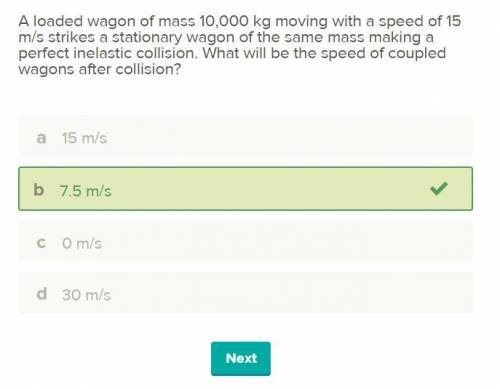
Physics, 15.02.2021 14:00 allenlog000
A loaded wagon of mass 10,000 kg moving with a speed of 15 m/s strikes a stationary wagon of the same mass making a perfect inelastic collision. What will be the speed of coupled wagons after collision?

Answers: 2
Another question on Physics

Physics, 21.06.2019 22:30
Follow these directions and answer the questions. 1. shine a pencil-thin beam of light on a mirror perpendicular to its surface. (if you don't have a laser light as suggested in the video, you can make a narrow beam from a flashlight by making a cone from black construction paper and taping it over the face of the flashlight.) how does the light reflect? how does the relationship of incident to reflected ray relate to the reflection of water waves moving perpendicular to a barrier? 2. shine a pencil-thin beam of light on a mirror standing on a sheet of paper on the table (or floor) so that you can mark the incident ray and reflected ray. (you can support the mirror from the back by taping it to a wooden block.) 3. mark a line on the paper representing the reflective surface. (the reflective surface of a mirror is usually the back edge.) 4. draw a dashed line perpendicular to the mirror surface at a point where the incident and reflected ray meet. this perpendicular is called a normal to the surface. 5. measure the angles between the rays and the normal. the angle of incidence is the angle formed by the incident ray and the normal to the surface. the angle formed by the reflected ray and normal is called the angle of reflection (r). what is the angle of incidence? what is the angle of reflection? 6. repeat for several different angles. (see report sheet for details.) what appears to be the relationship between the angle of incidence and angle of reflection? in science 1204, what was the relationship for these two angles made by the reflection of waves in a ripple tank? 7. roll a ball bearing so that it hits a fixed, hard surface (a metal plate) at several angles (including head-on). observe the way in which the ball bearing reflects. what generalization can you make about how a ball bearing reflects from a wall? have you proved that light can only behave like a wave?
Answers: 1

Physics, 22.06.2019 00:20
2.22/3.33 points | previous answers tamucolphysmechl1 4.pre.002. ask your teacher my notes question part points submissions used on a frictionless air track, a blue glider with mass 0.200 kg is moving to the right with a speed of 8.00 m/s. it strikes a red glider that has mass 0.600 kg and that is initially at rest. after the collision, the blue glider is moving to the left with a speed of 2.40 m/s. (a) what are the magnitude and direction of the velocity of the red glider after the collision? magnitude 3.33 m/s correct: your answer is correct. direction correct: your answer is correct. (b) is this collision elastic?
Answers: 1

Physics, 23.06.2019 00:30
Why does the equilibrium position of the spring change when a mass is added to the spring? will the mass oscillate around the new equilibrium position of the spring or the previous position without a mass attached to the spring? if the equilibrium position of the spring changes by 20 cm (assuming no initial mass) when a mass is added to the spring with constant 4.9 kg/s^2, what is the mass of the object attached to the spring?
Answers: 2

Physics, 23.06.2019 02:00
Athird point charge q3 is now positioned halfway between q1 and q2. the net force on q2 now has a magnitude of f2,net = 5.861 n and points away from q1 and q3. what is the value (sign and magnitude) of the charge q3?
Answers: 2
You know the right answer?
A loaded wagon of mass 10,000 kg moving with a speed of 15 m/s strikes a stationary wagon of the sam...
Questions


Mathematics, 30.03.2020 00:29



Chemistry, 30.03.2020 00:29





Mathematics, 30.03.2020 00:30




Mathematics, 30.03.2020 00:30


Mathematics, 30.03.2020 00:30



Mathematics, 30.03.2020 00:30

Mathematics, 30.03.2020 00:30




